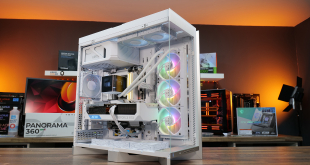It's been over two years since we last updated our GPU benchmarking system, so with the recent release of Intel's Comet Lake-S desktop platform, we thought it was high time to make the switch and prepare ourselves for the next generation of GPUs. PCSpecialist put together a brand-new system for us, built around the ten-core i9-10900K processor, and here we go over all the details.
Specification
- Case: Fractal Meshify S2 Blackout Tempered Glass
- Processor (CPU): Intel Core i9 Ten-Core Processor i9-10900K
- Motherboard: ASUS ROG Maximus XII Hero Wi-Fi
- Graphics card (GPU): Varies
- Memory (RAM): 32GB Corsair Vengeance DDR4 3600MHz (4 X 8GB)
- 1ST Storage Drive: 2TB Samsung 860 QVO 2.5″ SSD, SATA 6Gb/s
- 1ST M.2 SSD Drive: 500GB Samsung 970 Evo Plus M.2, PCIe NVMe
- Power Supply: Corsair 1200W HX Series Modular 80 Plus Platinum
- Processor Cooling: Corsair H115i RGB Platinum Hydro Series
- Operating System: Windows 10 Home 64 Bit
With our previous GPU benchmarking system based on Intel's ageing, and now discontinued, Core i7-8700K processor, we wanted to bring the system up to date in 2020, and that is exactly what we have done by building this new machine around the Comet Lake-S flagship – the i9-10900K. Leo recently reviewed this processor and found it to be a stellar gaming CPU, and that is exactly what we are looking for here. We are well aware that Ryzen processors can offer better all-round value, but our sole purpose for this machine is to benchmark graphics cards, and to that end the i9 is the best chip for the job.
As the i9-10900K is a 10-core beast, we also need a very solid motherboard to ensure unwavering stability, and that is what we have got with the ASUS ROG Maximus XII Hero. Leo also reviewed this board just last week, and it walked away with our ‘Must Have' award, so we can't say better than that. It's proved easy to work with and we dialled in a 5.1GHz all-core CPU overclock without a hitch.
Alongside the CPU and motherboard, PCSpecialist equipped this system with 32GB Corsair Vengeance DDR4 memory, running at 3600MHz CL18. Our previous GPU benchmark rig had 16GB memory, and we'd still say this is enough for the majority of gaming systems. However, upping the capacity to 32GB means we can be confident we won't be memory-limited during our testing, while the 3600MHz frequency offers good speed.
Cooling the i9, we have Corsair H115i RGB Platinum 280mm AIO. This not only adds some RGB pizzazz to the system, but it offers more than adequate cooling. Temperatures after a 30-minute 3DMark Time Spy stress test didn’t go above 60C for the processor, and as this machine is going to primarily be running games, it is more than enough for our needs.
Other things to note include our storage drives, starting with a 500GB Samsung 970 EVO Plus, which houses our OS and key applications like Steam and Origin, while a 2TB Samsung 860 QVO provides more than enough storage for our games library. We also have a beastly 1200W Corsair HX1200 PSU, which is almost certainly overkill for our needs. However, it again provides peace of mind that we will never be running into issues with power draw, which is prudent after rumours suggest Nvidia's next-gen flagship will have a 350W TDP.
So that is the key system hardware covered, but another thing to discuss is the choice of case. This marks a shift for us as our previous system was an open-air test bench, using a Streacom ST-BC1 frame. While open test benches are convenient and means chassis cooling and airflow is simply not a factor, I’ve been wanting to test in a case for a while, for one simple reason – it provides ‘real world’ data that you just don't get from an open bench, as almost everybody buying a new graphics card is going to put it inside a case. This way, we know the data we are presenting is going to be more relevant for more people, than when we used our open bench.
Of course, we also wanted a high airflow case so the graphics card isn’t going to be choked, so here we have the excellent Fractal Design Meshify S2. This uses two 140mm intake fans at the front, with one exhaust at the rear, while the two fans from the AIO are also exhausting through the roof.
So there we have it – the new KitGuru GPU benchmarking system. We've got a lot of content and testing planned over the next couple of months, and of course next-gen hardware is not too far away now. Stay tuned for more reviews, game benchmarks and head-to-head comparisons in the coming weeks!
We'd also like to say a special thank you to PCSpecialist for building this machine for our testing. We've reviewed a number of their systems over the years, with the most recent being the Vortex S3, and I am certainly impressed with the build quality on show with this machine. To configure your own system from PCSpecialist, visit their website HERE.
Discuss on our Facebook page HERE.
KitGuru says: Let us know your thoughts on this new machine, and if there are games you'd like to see us benchmarking in our GPU reviews, please do let us know!
 KitGuru KitGuru.net – Tech News | Hardware News | Hardware Reviews | IOS | Mobile | Gaming | Graphics Cards
KitGuru KitGuru.net – Tech News | Hardware News | Hardware Reviews | IOS | Mobile | Gaming | Graphics Cards














